‘A lot of pain’: The hangover looming from Australia’s budget-wine boom
Grapes rotting on vines; billions of bottles’ worth of wine sitting in tank farms, wanted by no one. Australia’s inland bulk wine producers are in crisis, causing an image problem for the wider industry.
By Luke Slattery
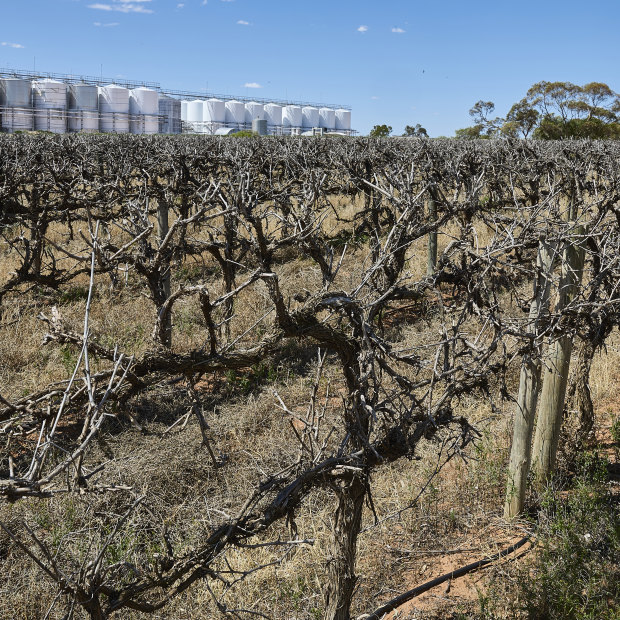
At a vineyard near Berri, in the South Australian Riverland, tank farms are dotted across the landscape.Credit: Duy Dash
Brian Croser claps a heavy hand on my shoulder and drags me in from the cold. The South Australian winemaker is heading into his 56th vintage, polishing his memoirs, and wrestling with a demon – the demon of regret. But first, a glass of his Tapanappa chardonnay and a polemical pinot noir – served to make a point. There’s no better place to be on a rain-thrashed night, it occurs to me, than the home of a genial vigneron.
Croser’s name will be forever linked to Petaluma, the premium brand he launched in the late 1970s with fruit from Piccadilly Valley – Croser was the first winemaker to plant here – in the Adelaide Hills. Swallowed up by global booze behemoth Lion Nathan in 2001, Petaluma, the brand and the winery, has since been passed like a baton from one owner to the next, along with Croser’s eponymous bubbly. With his stern gaze, patrician tone and moustache, as meticulously tended as his vines, Croser has served for the past few decades as unofficial spokesman for, and critic of, the industry that’s been his life. He is described to me by Andrew Caillard, author of The Australian Ark, a three-volume history of Australian wine, as “singularly the most important wine figure of his generation”.
On this stormy night in the Piccadilly Valley, I find 76-year-old Croser the vigneron a model of serenity; Croser the wine industry statesman – not so much. The walls of his study are scattered with photos of his wife, Ann, and their three daughters, and a farrago of wine mementos. The most significant of these is a 2004 cover of Decanter magazine, the global wine industry’s bible, anointing Croser “man of the year”.
The moment I pull up a chair, he gets straight to the point. “Yes, I’ve been a successful winemaker,” he declares, as if prompted by the Decanter cover. “But in one important respect, I’ve failed. Hundreds of speeches and I’ve not been able to guide us in the right direction: towards quality. For decades, nothing changed. And now, well, so much is going to change – because it has to.”
As Croser sees it, the Australian wine industry has split into a “fine-wine community of more than 2000 committed and regionally diverse producers” and a shrinking number of big companies. Three of these wine behemoths – Treasury Wine Estates, Accolade Wines and Pernod Ricard – are among the world’s biggest. But the Monopoly board of world wine is constantly in play and Pernod Ricard recently sold its wine businesses to Accolade. It’s in the nature of these big operations to maintain a few halo brands – Accolade owns Petaluma, Treasury maintains Penfolds – while also producing budget export wine en masse in the hot inland regions of the Riverland, Riverina and Murray-Darling. According to Wine Australia, in the 12 months to September 2024, the warm inland regions – under the label South Eastern Australia – accounted for 79 per cent of the volume of wine exported below $10 per litre.
Both bulk- and fine-wine makers have “commercial legitimacy” in Croser’s eyes. The problem is that from the mid-1990s, the bulk-wine sector underwent steroidal growth, exporting increasing volumes of budget bottled wine, casks and shipping container-sized wine bladders at ever-diminishing prices. But since 2020, demand for bulk wine has crashed, with formerly welcoming markets – chiefly the US – turning flaky as early as 2008. The value of Australian wine exports to the UK peaked in 2007 at $990 million and had fallen to $362 million by September this year. As a result, lakes of low-end Australian wine are filling “tank farms” in warehouses here and abroad. As of June 2023, there were 2.19 billion litres of wine in stock across Australia – in bottles, barrels and steel tanks.
These wine reservoirs, representing more than two-and-a-half times the volume of Australia’s annual exports, aren’t going anywhere fast because nobody wants them. Croser has long feared mass-produced, low-end wine’s domination of the export market and its potential to “obscure” the small players – the makers of fine wine, or at least regionally varied and interesting wine. And now there’s the “current tragedy”, as he calls it, in the vast, irrigated flatlands.

Abandoned grape vines near Berri in South Australia.Credit: Duy Dash
Ahead of our meeting, Croser sends a sketch of the industry’s agonies. His source is a report by wine economist Kym Anderson, approved by state and federal agriculture ministers in July and awaiting a ministerial response. Commissioned by the government’s Viticulture and Wine Sector Working Group, the report describes how the average price of red-wine grapes in the hot inland regions (for growers lucky enough to find a buyer) fell to near-record lows in each of the three vintages to 2024. “Together with low yields in 2023, many small growers have been struggling to put food on their table,” Anderson’s report says. “Wineries with unsold wine are also struggling, especially those with tanks full of wine from previous vintages.” Riverland growers are lucky to get $150 a tonne for their grapes. In the industry’s new cool-climate frontier of Tasmania, by contrast, wine grapes fetch close to $4000 a tonne.
The lucrative Chinese market collapsed in 2020 with the imposition of crushing tariffs, and while their removal this year has triggered a surge in the value of Australian wine exports, the bounce-back won’t ease the pain experienced inland. The status-sensitive Chinese are buying premium wine in relatively small volumes, not bucketloads of budget wine.
The analyst at industry body Wine Australia, Peter Bailey, explains that the return of China this year soaked up the equivalent of 59 million litres, whereas surplus red wine nationally leading into the 2024 vintage was about 400 million litres. “China is not going to solve any oversupply issues,” he says.
‘We need to bridge the gap between the increasingly poor external perception of Australian wine and the realities of Australia’s vibrant fine-wine community.’
Brian Croser
The unpalatable truth for the Australian wine industry is that mass-produced, low-end wine – our specialisation – is the dying sector of the global market. Says Bailey: “That’s the end of the market that’s declining, and that’s the end of the market where Australia has its biggest profile. People around the world are reducing their consumption at that end of the market. It’s in decline, and will continue to decline.”
While the crisis is not of Brian Croser’s making, it weighs heavily all the same. Like many Australian winemakers, he was cheered by the international recognition given to Australian winemaking from the early 1980s. No longer an Anglo-Irish outpost of beer, bangers and mash, Australia seen through wine-tinted glasses was a Mediterranean-like culture attuned to its climate and post-war, wine-drinking migrant communities.
The industry’s failure to galvanise around the “fine wine scene” – well-established by the early 1990s – is seen by critics like Croser as a form of commercial self-harm. Rather than chase quality, the industry chased volume; instead of nurturing the reputation of Australian wine, it debased that reputation in the pursuit of short-term profit. About 60 per cent of Australian wine leaves our shores in shipping containers, mostly as bulk in outsized rubber bladders. The average price of our exported wine is a lowly $3.72 a litre.
“From the 1990s, we had massive growth of the industry,” Croser says. “Not all of it for export – the domestic industry was growing as well. By the end of the 1990s, the inland areas of Australia had been over-planted with vines. There was competition between Orlando’s Jacob’s Creek, Casella’s Yellowtail, Hardys’ Nottage Hill, Koonunga Hill from Penfolds, and these companies were offering generous contracts to inland grape growers – they all wanted a share of this booming market. There was added fuel in the form of tax incentives. Big investors entered the market.
“By 2010, it was obvious that the inland areas had been way overplanted,” Croser says. “At the same time, budget brands had become the main image of Australian wine overseas – that image was now dominated by the inland areas, hot-climate wine, sold in supermarkets, produced on an industrial scale.” The suggestion that Australian wine was “industrial”, tricked-up, or fake had become an established trope in international wine appreciation. “The image of industrial winemaking overshadowed the fine-wine industry, making it harder for Australian fine wine to be recognised on its own terms.”
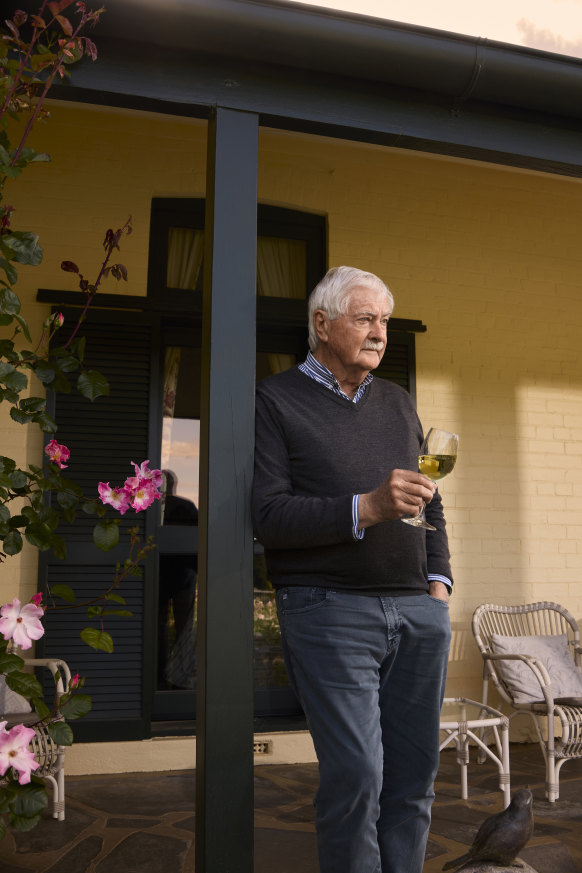
Brian Croser: “The image of industrial winemaking overshadowed the fine-wine industry, making it harder for Australian fine wine to be recognised on its own terms.”Credit: Duy Dash
There’s a touch of the Jedi Knight wielding his lightsaber against the dark side of the Force in Croser’s argument with the “inlanders”, as he calls them. Is it really so cut-and-dried?
The topography of the Australian wine industry is fiendishly complicated. The big companies that run the inland industry are, in some cases, the same companies that own, support and promote some of the country’s finest wines. House of Arras, the winner in 2020 of a Decanter gong for world’s best sparkling, was until recently in the Accolade fold; Grange Hermitage is a product of Penfolds, which is owned by Treasury.
Croser’s abiding passion, he insists, is quality. But quantity, for the past quarter of a century, has ruled. “There are influential people in the industry who say that all Australian wine is fine wine,” he tells me. “The biggest challenge for Australian wine broadly is the negative and deteriorating image problem created by the behaviour and travails of the branded commodity [mass-produced budget] wine industry. We need to bridge the gap between the increasingly poor external perception of Australian wine and the realities of Australia’s vibrant fine-wine community as it exists in the 65 fine-wine regions of Australia, 24 of which are as cool or cooler than Bordeaux in France.”
Swish goes the lightsaber. Swish. Swish.
Next morning, I set out for the South Australian Riverland to view the “tragedy”, to use Croser’s word, or at least the “crisis” evoked by economist Kym Anderson. I’ve been invited to a seminar for grape growers struggling to make ends meet, organised by Riverland winemaker and entrepreneur Ashley Ratcliff. Leaving the manicured slopes of the Adelaide Hills, I head west from the Mount Lofty range into sheep country and scrub. Once in the flats, I’m on a ribbon of road leading past towns bearing traces of German settlement – Schubert Street, and a rivulet named after the Rhine until anti-German wartime sentiment forced a name-change to the French river Marne. Crossing the copper-coloured Murray by car ferry at Swan Reach, I drive to the regional hub of Berri, past an ocean of vines as the sky purples and a distant storm sweeps across the hard-cut horizon.
The vineyards should be neat, bare and carefully pruned at this time of the year as they await the bud-burst of spring. And many are. But here and there I pass vines abandoned or neglected. I pull over and walk a row. Bunches of desiccated red wine grapes, like black petals, turn lightly in the northerly wind that shears across the flatland. A bitter harvest – 2024.
Size matters a great deal to the Riverland wine industry. A jolly yellow and blue online brochure boasts a 410,888-tonne wine grape crush in 2023, “accounting for 62 per cent of South Australia’s and 34 per cent of Australia’s annual crush”. But statistics also speak to the region’s despair. The Riverland grape crush for 2023 was the lowest in a decade. This year, it declined a further 5 per cent. It’s expected to decline again next year. In the 12 months to April, about 120 hectares of Riverland vines were torn out as grape prices crashed or, in the bureaucratic phrasing of Wine Australia, showed “a significant downward shift”.
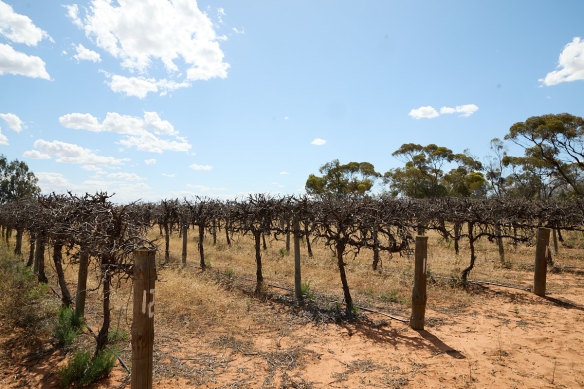
This abandoned vineyard in Berri should be neat, bare and carefully pruned at this time of the year.
Ratcliff’s Ricca Terra label has established a reputation for quality and innovation in the Riverland. He has planted grape varieties such as arinto and souzao from Portugal, which he blends with southern Italian varieties including nero d’avola to create unlikely mixed marriages. For sure, he sees “a lot of pain in these parts”, he tells me. But he’s an entrepreneur, and when he looks to the future, as he habitually does, any number of alternative agricultural pathways open up: olives, pistachios, pomegranates, to name a few. When not promoting these off-ramps for struggling grape growers, he’s working hard to prove a point: good wine can be made in the Riverland.
On the morning of Ratcliff’s seminar for grape growers who want out, I meet Martin Bailey, proud owner of a diminutive six-hectare Riverland block. Bailey is a rangy Kiwi who married a local girl, Judy Till, from a farming family. Her grandfather, Clem, worked what became known as Till Farm under the soldier-settlement scheme for veterans of the Great War. “It was just Mallee scrub in those days,” says Bailey. “Everyone joined together to clear the land and build the homes. Clem Till planted fruit trees and vines for table grapes but in the 1990s, in the wine industry’s boom years, it was all ripped out and the whole block was transplanted with cabernet sauvignon.”
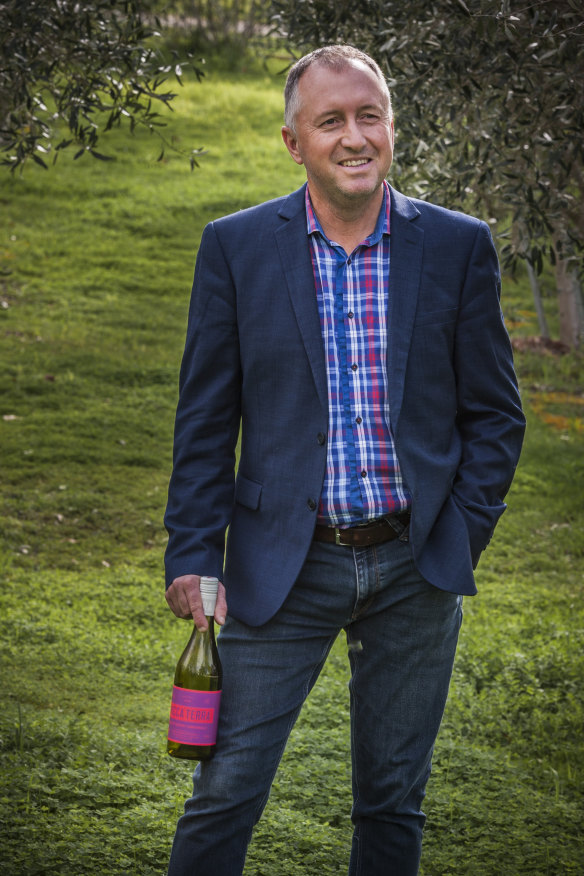
Ricca Terra’s Ashley Ratcliff is out to prove that fine wine can be made in the Riverland.
When the couple took over Till Farm in 2017, they were getting about $480 a tonne for their grapes. The price fell to $345 a few years ago, and plummeted to a desperate low of $125 last year. By their reckoning, they’ve earned $35,000 in the past two years from grapes and spent twice that amount watering, fertilising and harvesting the crop. “People are running away because they can’t make a living,” Bailey tells me over a coffee outside the seminar room. “There are a lot of folk who’d like to be here this morning but aren’t.” He cuts a quick look over his shoulder. “They’re third- or fourth-generation grape growers. It’s shame that keeps them away.”
‘There are (Riverland) winemakers … producing absolutely banging wines that stand up against anywhere else in Australia.’
Ella Winnall, mayor, Berri-Barmera Council
The region’s grape growers, about half of them “blockies” like Bailey, working soldier-settlement farmlets of 10 hectares or less, provide a contracted volume of grapes to a local cooperative, which sells them to the big producers. He has never been given any encouragement to improve the quality of his grapes, he tells me. “The contract stipulates that they will take all the grapes we can provide, but they don’t want too much MOG [matter other than grapes].” He doesn’t know where or in what form the wine from his grapes makes its way overseas, but he suspects most ends up in casks.
The mayor of the Berri Barmera Riverland region, 33-year-old Ella Winnall, was raised on a soldier-settlement block much like Martin and Judy Bailey’s during the Millennium drought. Her parents got out of grapes towards the end of the drought, turned off the water, and pulled out the vines. She stayed on in the region. “Our community is quite reliant on the wine industry,” she tells me. “When the industry is going through a rough time, we feel it across the whole community – some of our main-street businesses like retail can be hurting just as much.” She repeats a plucky phrase often heard in the Riverland – it’s the “engine room” of the wine export industry. “It’s not all we do here though, we have some incredible grape growers and winemakers who are at the forefront of sustainable winemaking and are producing absolutely banging wines that stand up against anywhere else in Australia.”
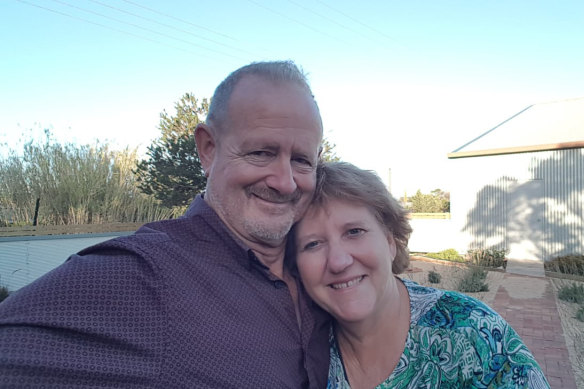
Regional growers Martin Bailey and Judy Till have seen prices plummet over the past few years.
I push on down the road to Salena Estate winery, rising from the roadside a few kilometres south of Berri, close by a bend in the Murray River, to find the lights out and no one home but owner-manager Bob Franchitto. Salena, in its prime, was one of the nation’s top 20 wine producers, pumping out 15,000 tonnes a year of bulk, cask, and some premium wine. Franchitto has agreed to meet me six months after his family-owned company went into receivership, owing $25 million, with 5 million litres of unsold bulk wine in storage. The son of post-war migrants, Franchitto is clean-shaven, with close-cropped hair and the unflinching gaze of a realist. Rather than an exit strategy, he’s looking for a financial lifeline. “I still believe there’s a future here but it’s going to be a tough road ahead,” he says over coffee in the empty boardroom of a business that once employed 40 people, ran a cellar door – even a restaurant. “This has been our life. We built this from nothing. It’d be sad to see it go.”
He bought part of the land on which Salena sits in 1991 and he and his wife, Sylvia, planted vines over the next few years. The couple started out with one barrel to share with friends, followed by three the next year, and 30 the year after that. They launched Salena Estate in 1998 with 300 tonnes of mainly cabernet and shiraz. “All the demand was in red,” he says. “In hindsight, it would have been better to have a bit more white.”
Thanks to an organic certification covering half the property, he found an early market in Scandinavia, but it was the Chinese thirst for Aussie red that supersized the 185-hectare Salena Estate. “We first went to China in about 2000 with a few containers a year and then suddenly it started to take off, peaking with 4 million bottles a year. About 70 per cent of our product went to China … But then Scott Morrison poked the dragon and overnight that market was gone.” Franchitto believes the Riverland wine industry needs to shrink by at least 20 per cent to match diminished global demand.
Asked to identify the industry’s biggest missteps, his response is to the point. “There was a plan to increase production to where we were a few years ago. We got there in a hell of a hurry. We got there 20 years ahead of time. It all happened too quickly.”
An hour’s drive north-west of Salena Estate, I pass through Cooltong – “lizard” in the local Aboriginal dialect – and head into irrigated grape and citrus-growing country, sliced into narrow soldier-settlement blocks facing the red desert: two regions to the immediate north list their official population as zero. It’s platter-flat country, though pretty today with a light dusting of apple-green leaf on the fruit trees and a haze of pale pink blossom over the almonds. I’m here to meet Jack Papageorgiou, a farmer who has been outspoken in his calls for financial assistance packages to help grape growers to either struggle on with dignity or get the hell out.
‘As a grape grower, I’ve seen many challenges, but I just can’t accept the industry has fallen to such a low level.’
Jack Papageorgiou
Where Martin and Judy Bailey are exploring exit options, and Bob Franchitto is pleading with the banks, Papageorgiou has come to feel “imprisoned” on the 30-hectare vineyard he’s worked since 1974. The returns from his vines are so poor, he tells me, he’s been forced to tap his wife Poppy’s superannuation to the tune of $150,000 just to keep going. Heavyset and softly spoken, dressed in baggy jeans and a zipped-up sweater, Papageorgiou invites me into the family home and pours fresh orange juice from his orchard. He’d sell the land if he could find a buyer, but the banks won’t readily finance vineyard sales. “As a grape grower, I’ve seen many challenges, but I just can’t accept the industry has fallen to such a low level,” he says, putting a hand to his furrowed brow. “For the past three years, we’ve been selling grapes below the cost of production. We can’t sustain that. It’s unacceptable.”
The farmlets in this bend of the Murray were opened up by the post-World War I soldier-settlement scheme that lured Clem Till to the Riverland. An irony not lost on Papageorgiou is that many of his neighbours are soldiering on, suffering silently. He has formed a club for grape growers who’ve lost confidence and purpose. Depression, he says, is rife in the Riverland. “You can see it in their eyes,” he tells me. “They’re wondering, ‘What’s the point?’ ”
While I was on the road in the Riverland, the industry released a One Grape & Wine Sector Plan report, acknowledging that the “sector” had been “pushed off course”. For the Australian wine industry to extract itself from the mess it is in, the report stressed the need for “collaborative efforts from all parties …” calling for a “cohesive national brand that unites the sector in promoting Australian wine”. Already, though, it’s clear the wine industry in Tasmania – the industry’s cool-climate El Dorado – is keen to disassociate itself from Australian wine, while many premium winemakers see the inland with its agonies as an oversized chain dragging on their ambitions.
A long, slow-ripening season benefits most table grape varieties, hence the race to the country’s southern fringes and its cool uplands. In hot regions, winemakers aiming for some degree of finesse are forced to pick early to maintain a palatable balance of sugar, alcohol and acidity, with a consequent loss of flavour and fruit intensity. Quality sparkling wine from chardonnay and pinot noir – the mainstay of the Tasmanian wine industry – is almost by definition a creature of cooler climates. Grapes for quality bubbly are picked early and sweetened just before corkage with a dollop of sugar syrup: the “dosage”.
A half-hour’s drive north of Hobart at Tea Tree, in the Coal River Valley, I pull into the five-hectare vineyard of New Zealand-born and -educated Samantha Connew. The hills under thin spring sunshine are glowing green after weeks of heavy rain. By late February, these hills will bleach out and the sheep will turn dirty-grey. Connew invites me into a small, tidy picking shed, makes coffee and sets a welcoming gift of six speckly eggs from her home-raised chooks on the table.
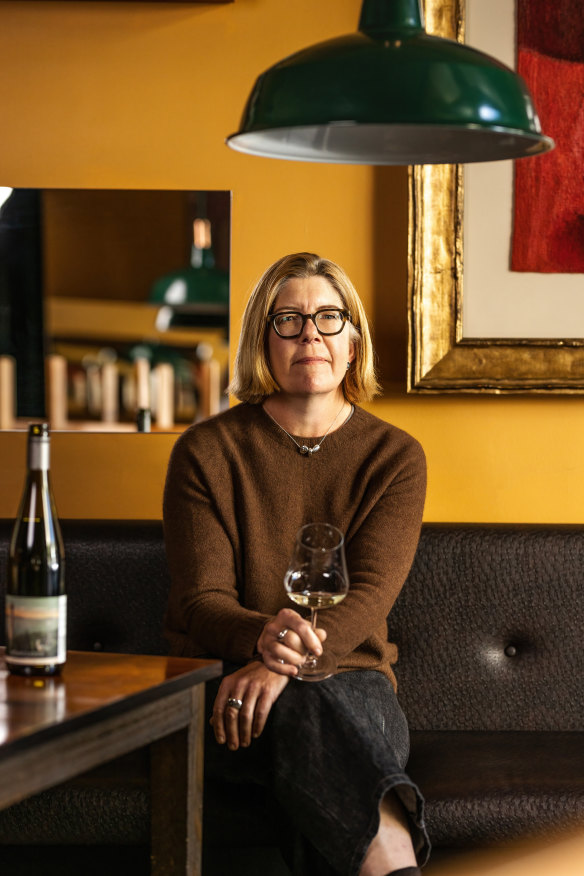
Tasmanian winemaker Samantha Connew is profiting from the demand for the state’s cool-climate wines.Credit: Adam Gibson
For her Stargazer label, Connew grows a fruit salad of pinot noir, riesling, gamay, chardonnay, pinot blanc, gewürztraminer and pinot gris. Her approach is at once classical and unconventional, her wines a delight. She lives and works in a world far removed from the big-sky Riverland with its
industrial-scale tank farms, its unwanted wine lakes, and its air of brittle desperation. Her talk is not of contraction but modest expansion: a few additional hectares under vine and a cellar door aimed at the 27 per cent of visitors to Tasmania who are keen to taste wine. She has never “pursued growth for growth’s sake”, she stresses. “Life can get complicated when you get into that growth cycle. But such is the demand for Tasmanian wine that I’d be stupid not to take advantage.”
Connew started working at Wirra Wirra winery in McLaren Vale more than two decades ago, reeling in the 2007 red winemaker of the year award at the International Wine Challenge. “As soon as we say our wine is not for everyone, everyone wants it,” she says. “It’s the whole scarcity thing.”
‘There will always be a fine-wine market. But the bulk market is basically unsustainable.’
For the better part of a century, Tasmanians have been carping about their island state’s not infrequent omissions from the map of Australia. The flourishing Tasmania wine industry now actively disassociates itself from Australia: it is Tasmanian first and foremost. In Italy, the wine lists of the better restaurants are segmented into regions: Liguria, Tuscany, Alto Adige. Tasmanian wine lists are likely as not to feature Australian wine and, in a separate category, Tasmanian. The term “New-Mania” has been coined in Tasmanian wine marketing circles to express an affinity, viticulturally speaking, with New Zealand. Sheralee Davies, chief executive of Wine Tasmania, tells me: “We want people to consider Tasmanian wine in a global, more than an Australian, context, comparing it with other cool-climate international wine regions, such as parts of New Zealand and the similar things it represents – cool climate, quality and elegance.”
There are fears, nevertheless, that the crisis of the mainland wine industry will be visited on Tasmania, that growth will diminish quality and big investors will come to dominate what has always been a small island industry. Some companies have had a long presence in Tasmania, such as Hill-Smith Family Estates with Jansz sparkling and Dalrymple, and Accolade with Bay of Fires and House of Arras – the latter label recently sold to a relative newcomer, Handpicked Wines. Though based in Victoria’s King Valley, Brown Brothers invested in Tasmania in 2010, with its Devil’s Corner label and vineyards in the Tamar Valley and on the east coast. Western Australia-based Fogarty Wine Group has been busily hoovering up Tasmanian land, vineyards and labels. Adelaide Hills company Bird in Hand recently followed suit with the purchase of a 180-hectare east-coast strip and a wedge of the Tamar Valley. Overseas wine companies and private investors are joining the vine rush; the Champagne house of Mumm makes a Tasmanian sparkling, while the US-based Jackson Family Wines has reportedly signalled its interest in Tasmania.
Connew isn’t overly perturbed. Tasmania, in her view, is perfectly placed to resist the trap of gigantism and high-volume wine production. Its twisty, hilly landscape and isolation will likely continue to nurture the future of premium wine. Wine Tasmania predicts that by 2040, Tasmania’s wine sector will be the island economy’s highest contributor, producing about $2 billion in wine value annually. “Our annual crush is 1 per cent of the national total,” Connew says. “And it’s 6 per cent of the total value. That in itself tells you something.”
Kym Anderson and Brian Croser agree we’re not going back to the old, low-end wine export industry, at least not its former scale. People are drinking less wine, less red wine, less cheap wine, less hot-climate wine. There is a deep awareness, too, of the fragility of waterways, particularly the Murray-Darling. Says The Australian Ark’s Caillard: “There will always be a fine-wine market. But the bulk-wine market is basically unsustainable. We cannot stay in the groove of being a commodity winemaker.”
At the same time, cool-climate premium vineyards don’t have a monopoly on the future of Australian wine. There will always be a place for decent wine that doesn’t break the bank. Croser, despite his decades-long argument with the inlanders, is full of praise for Ashley Ratcliff’s Ricca Terra label. So, too, is Sarah Burvill, winemaker at Bird in Hand, who over a wine tasting sings the praises of Ratcliff’s grapes and those of growers he’s worked with. “He’s really trying to elevate the quality of Riverland fruit, encouraging growers to give the crop a bit of extra attention, shift the thinking away from big volume, low price,” she tells me.
In late September, Ratcliff swept the field at the 2024 Riverland Wine Show, winning best single-vineyard wine with his Ricca Terra 2023 Soldiers’ Land Shiraz, a nod to good winemaking and a wink to the region’s century-old, soldier-settler heritage. I got word of Ratcliff’s success on the day the devastating spring frost descended on the Riverland. It will likely wipe out a quarter of the 2025 vintage, grinding the region’s already struggling growers deeper into the red Mallee soil. A week later, as this story was being prepared for publication, I learnt from Bob Franchitto that his pleas for a “financial lifeline” had been rejected, and he’d lost Salena. “My life’s work,” he said. “Gone.”
To read more from Good Weekend magazine, visit our page at The Sydney Morning Herald, The Age and Brisbane Times.